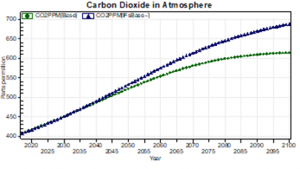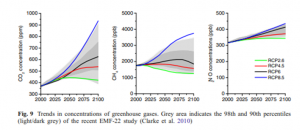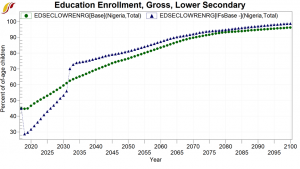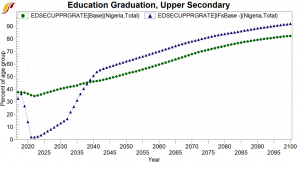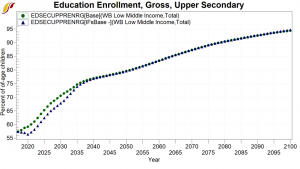Version 7.95 (April 14th, 2023)
Jump to navigation
Jump to search
PREVIOUS VERSION | INDEX PAGE | NEXT VERSION
You can download IFs Version 7.95 at 7.95 VB6 version and 7.95 NET version.
Interface Updates
- Fix to add countries, avoid trying to add a new country to HistMigration.
Model Updates
- Handling Big Negative Drops in Precipitation.
- Added multipliers for FOODSECURITY, WOMENINLEADERSHIP and UNPAIDLABOR.
- Added absolute elasticity logic to handle temperature to gini relationship.
- Moved FillSmokingRateHistCP down in initialization because it needs GDPPCP, which was a problem for the new countries.
- Added parameter to hide warnings when doing regionalization, too many with new region with little data, example MIGRATEIN, MIGRATEOUT, ENVTEMPCHG, ENVPRECIPCHG, ENVTEMP, ENVPRECIP.
- Changed Smoking Impact initialization to use CGDPPCP instead of pre-saved value from table.
- Added condition to filling holes for CCLPCCV, needs CCLPCMDER to be there.
- Drug Consumption variable needs a seed to be used as a driver.
- Handling 0 when Precipitation is 0 for Yield calculation.
- Validations to save SVDTHSSELFHARM, SSVDTHSPOLICS, avoid division by 0.
- Handling zeros in CLPCCV and CLPCMDER for Calories Distribution Implementation.
- Created a new procedure to compare all variables between base and working file for run to run analysis.
- Avoid recomputing DIPLOIGO in year 1, run to run.
- Need to use saved POPURBAN to compute INFRAELECACCPOP, run to run.
- Converting to single data type for UNPAIDLABOR, FOODSECURITY and WOMENINLEADERSHIP.
- LABWAGE was using HHINCEARN(R%, NSkill%) which was not yet computed, run to run. MFPRATET can't be computed in year 1 because MFPGROWTH is empty. Added comments to avoid normalization of Poverty.
- Stop recomputing YIELDINT in year 1, RUN TO RUN FIX.
- Using Mali as a proxy for Sahrawi population by age/sex data
- Making 0 a few renewable energy variables, solar, geo, tidewave, photo, wind when Null Handling ENPRRRen when there's no data. This fixes a significant increase in CO2PPM, which was coming from an increase in Fossil Fuel Production.
- You’ll see that the change brings us back close to a pattern very much like RCP6 (as in 7.49 ; 7.48 was actually lower and too low, more like RCP4.5), in contrast to one in 7.94 that pushed us quite a lot higher (although not to RCP8.5 as Jonathan correctly pointed out). Below that is explanation of the problem for which I am sending a fix.
Compare with van Vuuren et al at https://link.springer.com/article/10.1007/s10584-011-0148-z
The reason for the much higher CO2PPM in 7.94 than 7.48 or 7.49 is two-fold:
- There must have been an update of the IEA energy production data series for various renewable sources including tide-wave, geothermal, photovoltaic, wind, etc. See SeriesEnProd….IEA. In 7.48 the tide wave table, as an example, had non-zero values for only a half-dozen countries and lots of zeros for other countries (also some nulls). In 7.94 that table still had the half-dozen non-zero countries, but nulls for all others. I don’t know what the original source has, but I would much doubt that all other countries were missing data rather than being zeros. Tide-wave energy production is almost non-existent around the world.
- In the code, if any of the renewable sub-categories have a null value, the growth rate of the entire renewable category (enprr) was being set at 4.5%, well below the growth in many/most countries in the larger subcategories like wind and photovoltaic. So the growth rate in the US, for example, was showing as 4.5% because of the null in the tide-wave category rather than the more than 10% annual growth being experienced in the big renewable categories. In the run of the model, fossil fuel production growth was therefore to some degree forced up (into a crazy pattern in the US, for example) by the slower growth of renewables.
In the next update of the energy data, we should pay attention to make sure that somehow zeros are not coming in as nulls. But my code changes now treat all nulls as zeros, so the big renewable categories, for which most all countries have real data and growth, are not accidently written off.
- Fix graduation rate in lower secondary and grade by grade enrollment data. The fixes involved making estimated graduation rate follow the rule of not crossing the data on enrollment rate, and extending grade data read a couple of more years so Nigerian grade data is read.
Data Updates
- Added Kiribati and Sahrawi
